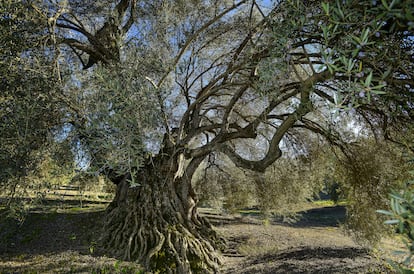The candidacy of the Andalusian Olive Grove Landscape for UNESCO World Heritage status has been definitively withdrawn due to the persistence of opposition from a significant number of farmers who understood that this declaration endangered the property rights of their olive farms.
The institutional commission that has processed this file has communicated the decision this Monday under the main argument of the 8,500 signatures against the declaration received from olive growers from the municipalities of Porcuna, Lopera and Arjona, in the Campiña de Jaén, as well as the reluctance that the Asaja Córdoba agricultural employers’ association had shown.
“This file cannot go forward against the will of the farmers,” said Francisco Reyes, president of the Jaén Provincial Council, in a tone of resignation, the institution that began this race a decade ago for the universal recognition of a unique and an ancient culture.
In this way, the candidacy Landscapes of the Olive Grove in Andalusia. Millennial history of a sea of olive trees It is definitively withdrawn despite the fact that the file was sent in January to UNESCO, which was going to debate its inclusion on the World Heritage List at the 2025 assembly.
The candidacy proposed the protection of 13,489 hectares of olive groves in five Andalusian provinces, Seville, Málaga, Granada, Córdoba and Jaén, and the file was endorsed by the five councils and universities of those provinces, the Junta de Andalucía, the Juan Ramón Guillén foundations and Savia and the main agricultural organizations. However, it has been Asaja, Coag and Cooperativas Agroalimentarias that have supported the withdrawal of the file as the opposition of a good number of farmers persisted.
Francisco Casero, president of the Savia Foundation, has described this decision as a “historic setback for the Andalusian olive grove” and has proposed, without success, that the file be reformed to eliminate the Porcuna region, where most of the olives come from. the signatures against the declaration: “Due to the opposition of one of the 14 areas included in the file, a project that was of vital importance for all of Andalusia has been sacrificed,” Casero lamented.
The red line of the olive growers
The olive growers who caused the withdrawal of the file argued that the ownership of their farms was in danger: “The condition to support the file is that the right to property, the decision of the affected farmers, and that no “There would be limitations to the productive capacity of the lands affected by the classification as world heritage,” Asaja, Coag and Cooperativas Agro-alimentarias de Jaén indicated in a joint statement.
From Asaja Córdoba, specifically, they described the proposal as “calamitous” for the interests of the olive growers. “Experience based on other similar situations indicates that, in the end, the farmer will end up being penalized,” warned Ignacio Fernández de Mesa, president of the association.
The general secretary of the Union of Small Farmers (UPA) of Jaén, Cristóbal Cano, has spoken, however, of a “unfortunate day” for the Andalusian olive sector. And he regretted that “the work, time and resources lost due to bad information, a lack of loyalty on the part of some actors in the sector itself and the political interference that has facilitated an impossible cocktail for the candidacy to prosper, a decision by the that we will regret in the future.” The president of the Córdoba agricultural employers’ association argued that, “with the regulations of the Common Agrarian Policy (CAP) and the sectoral regulations, more protection figures are not necessary, nor more limitations, since they are all already amply protected, which is very good. state of conservation and presenting magnificent biodiversity parameters.”
The file that is now being withdrawn identified 14 areas of cultural landscape, which have also been delimited based on the history of this landscape: Montoro and its surroundings (Córdoba), Molino Ducal San Fernando (El Carpio, Córdoba), Haciendas de Tavera and La Buzona, (Carmona, Seville), Hacienda de San Ignacio de Torrequemada (Aljarafe, Seville), Haciendas de La Soledad y Guzmán (Los Alcores, Seville), Cortijo La Jara (Jerez de la Frontera, Cádiz), terraces of Nigüelas and oil mill of La Erilla del Valle de Lecrín (Nigüelas, Granada), Olivares de Santa Catalina (Orcera, Jaén), El Ruedo (Almedinilla, Córdoba), Alfar de Écija (Écija, Seville), Cortijo Blanco (Periana, Málaga), Campiñas from Jaén (Porcuna and Lopera, Jaén), Hacienda La Laguna (Baeza, Jaén), and Zuheros (Sierras Subbéticas Córdoba).
The candidacy focuses on a cultural, agrarian, evolutionary and living landscape, whose values to be preserved have to do precisely with the continuity of its productivity and its economic, environmental and social sustainability. “A heritage landscape that is the result of the efforts of many farmers, who have dedicated their lives to the cultivation and care of these trees that have allowed and allow the livelihood of many families and territories in Andalusia,” highlight the defenders of the candidacy.
The evaluation process was scheduled to be carried out on the ground by UNESCO experts in the coming months, who planned to take into account authenticity, integrity, factors affecting the nominated property, limits, protection , its conservation and management.

